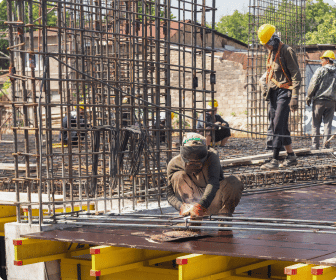Asbestos Exposure and Mesothelioma in Iron Workers
Ironworkers were exposed to asbestos while spraying asbestos coating onto steel beams, handling asbestos-coated metals, and working with industrial compounds such as adhesives and cement. Ironworkers with mesothelioma and other asbestos-related illnesses may be entitled to substantial compensation.













Home » Leading National Mesothelioma Law Firm » Asbestos Exposure » Occupational Asbestos Exposure » Iron Workers and Asbestos Exposure – Mesothelioma Risks
Ironworkers generally worked in commercial construction and factories, two environments with heavy occupational asbestos exposure. During the peak of asbestos use from 1930 to 1980, workers in all trades were exposed to asbestos just by working in commercial buildings. Ironworkers’ asbestos exposure is more significant because they built and installed the asbestos components.
Ironworkers are still being diagnosed with asbestos-related illnesses because of their exposure 20, 30, or 40 years ago. Some ironworkers may experience asbestos exposure today while working in older buildings. The Lanier Law Firm helps ironworkers identify their sources of occupational asbestos exposure and hold the responsible companies accountable.
Ironworker Occupations
Ironworkers fabricate and install structural iron and steel to support and reinforce buildings and infrastructure, such as bridges and roads, according to the Bureau of Labor Statistics. Ironworkers may have the following job titles:
- Welder
- Fabricator
- Fitter
- Erector
- Assembler
- Signal crane operator
- Rod buster
- Steelworker
The International Association of Bridge, Structural, Ornamental, and Reinforcing Ironworkers classifies ironworkers according to the types of structures they build or fabricate. These classifications include the following:
- Structural ironworkers
- Reinforcing ironworkers
- Ornamental ironworkers
- Rigging and machinery moving ironworkers
- Welding and burning ironworkers
Ironworkers in all of these occupations experienced significant exposure to asbestos until 1980 and are likely still experiencing asbestos exposure today.
Call 800-723-3216 now to see if our mesothelioma law firm can pursue compensation for you and your family. Consultations are free.
How Were Ironworkers Exposed to Asbestos?
Ironworkers are exposed to asbestos when they handle it directly or when they are present in environments where other workers are handling asbestos. While most ironworkers’ asbestos exposure occurred before 1980, ironworkers may be exposed to asbestos today when working in, demolishing, or renovating older structures. Asbestos becomes airborne when disturbed during the following activities:
- Cutting
- Drilling
- Burning
- Blasting
- Removing
The exact mechanism of exposure varies according to the type of work performed.
Structural Ironworkers

Structural ironworkers install metal beams to form building structures. Exposure may have occurred when applying asbestos spray coating to steel beams and girders for fireproofing purposes or when using other industrial adhesives and compounds to connect beams to other components.
Reinforcing Ironworkers

Reinforcing ironworkers add rebar to cement as a means to reinforce it. Asbestos was commonly used in cement to strengthen it. Ironworkers may have been exposed while mixing the cement. Reinforcing workers may also have been exposed while using asbestos-containing equipment such as hydraulic jacks and pumps, which typically housed asbestos-containing gaskets and wiring.
Ornamental Ironworkers

Ornamental ironworkers install stairways, railings, fencing, and other structures. They also install windows into masonry. These workers were exposed when applying asbestos-based spray coating and sealants to these structures or when using industrial glue, cement, or other compounds. The masonry into which windows were installed may also have been reinforced with asbestos.
Rigging and Machinery Moving Iron Workers

Rigging and machinery moving ironworkers work directly with heavy machinery and may be exposed to asbestos through components of the machines, including insulation, wiring, hydraulic pumps, gaskets, industrial compounds, and spray coatings. This could occur while using cranes, hoists, and forklifts. These ironworkers are likely to be involved in demolitions, where they may still encounter asbestos today.
Welding

Welding is a common task performed in all types of ironworking. Welders are often subjected to high-heat applications, requiring the use of fireproof protective clothing, including aprons and gloves, which used to commonly contain asbestos. Mesothelioma in welders is a high risk due to their occupational exposure.
Get a Free Legal Consultation
- Passionate legal advocates with decades of trial experience
- Billions recovered for our asbestos-exposure clients nationwide
- No upfront costs or fees
What Companies Are Responsible for Ironworkers' Asbestos Exposure?
The companies responsible for exposing ironworkers to asbestos include employers and asbestos product suppliers and include the following:
- BMI Refractory Service, Inc.
- Beazer East, Inc./Thiem Corp./Universal Refractories
- Bechtel
- Caterpillar, Inc.
- Columbus McKinnon Corp.
- Daniel International, Inc.
- Garlock Sealing Technologies
- H.B. Fuller Company
- Hopeman Brothers, Inc.
- Lyons Manufacturing, Inc.
- Morgan Engineering/Reunion Industries
- Pittsburgh Metals Purifying Division of Treesdale, Inc.
- Premier Refractories
- Reunion Industries, Inc./Alliance Machine Co.
- Santa Fe Braun, Inc./C.F. Braun & Co.
- Tellepsen Corp.
- York-Shipley Global, a Division of AESYS Technologies, Inc.
How Does Asbestos Exposure Impact the Health of Ironworkers?
A 1997 study published in the American Journal of Industrial Medicine analyzed the mortality of 13,301 unionized construction ironworkers. Researchers found that the mortality rates from pleural mesothelioma and asbestosis were markedly higher compared to the general population.
Mortality from lung cancer was significantly elevated, although not to the same extent as mesothelioma. The study also found an increased occurrence of other cancers.
The Lanier Law Firm Helps Ironworkers Recover Substantial Compensation
The Lanier Law Firm has been holding large companies accountable for asbestos exposure for more than 30 years. During that time, we have built a national reputation for consistently achieving remarkable verdicts and settlements for our clients. We get results because our attorneys are willing to go to whatever lengths necessary to ensure our clients recover the maximum compensation available.
Our mesothelioma lawyers represented 21 ironworkers who were exposed to asbestos at an Alabama steel mill, where they were required to cut metal pipe with a grinding wheel inches from their faces without protection. Our firm fought to move the case to Texas because it was a better venue for our clients, and they won a $115.6 million jury verdict.
In addition to a mesothelioma lawsuit, we help ironworkers file a variety of mesothelioma claims, including asbestos trust fund claims and workers’ compensation claims.
If you were an ironworker and have been diagnosed with an asbestos-related illness, your diagnosis is most likely a result of occupational asbestos exposure. We can help you identify the employers that exposed you to asbestos as well as the companies that supplied asbestos-containing products to them. Contact The Lanier Law Firm today for a free case evaluation.
Why Should You Trust the Lanier Law Firm to Handle your Mesothelioma Case?
Filing a Mesothelioma Lawsuit
Are you eligible?
What is the average settlement?
How long will it take?
